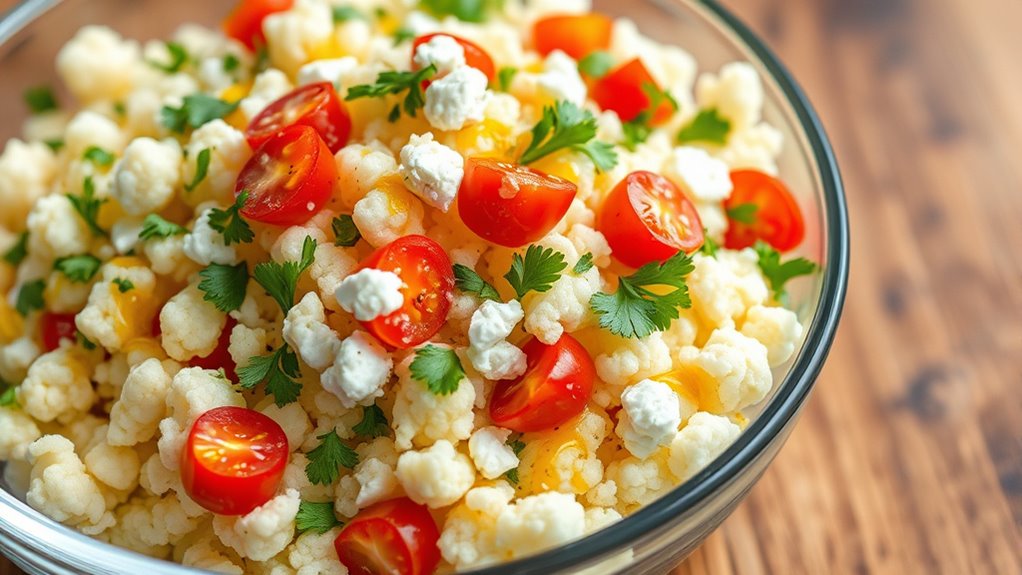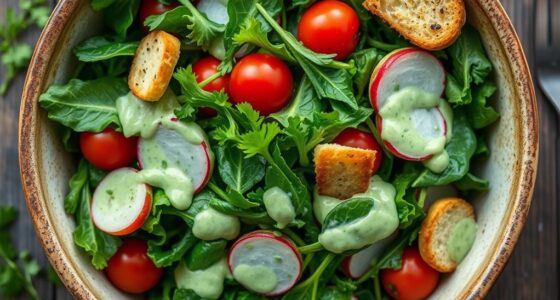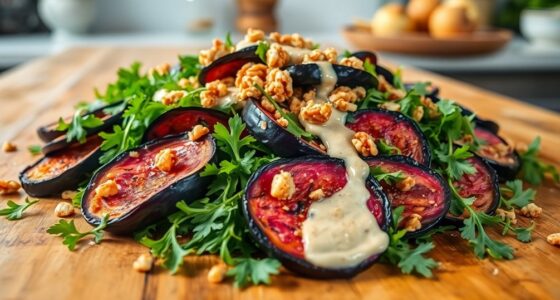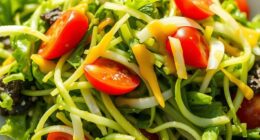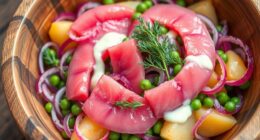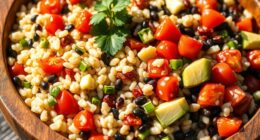Cauliflower couscous salads are a perfect low-carb alternative to traditional grain-based dishes. They’re quick to prepare and incredibly versatile, allowing you to customize flavors with ingredients like vegetables, herbs, or protein sources. The cauliflower provides a nutrient-dense base that absorbs flavors well, whether served raw or lightly cooked. This option fits into many meal styles, offering a healthy, satisfying twist on classic salads. If you keep exploring, you’ll discover even more ways to enjoy this tasty, low-carb option.
Key Takeaways
- Cauliflower couscous offers a low-carb, nutrient-dense alternative to traditional grain salads, supporting weight management and health goals.
- Its quick preparation and versatile flavor absorption make it ideal for creating customized, flavorful low-carb salads.
- Cauliflower couscous pairs well with fresh vegetables, proteins, and herbs, enhancing meal variety while maintaining a low carbohydrate profile.
- It can be served raw for crunch or lightly sautéed, providing flexible textures suited for different dietary preferences.
- Using cauliflower couscous boosts vegetable intake and offers a satisfying, healthy option for those on low-carb or keto diets.
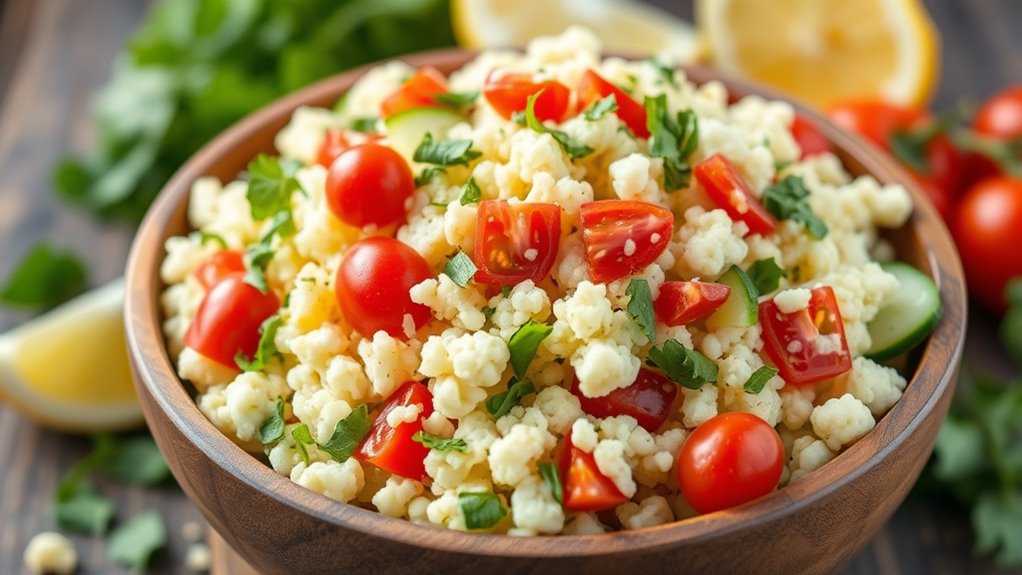
Cauliflower couscous salads offer a fresh, low-carb alternative to traditional grain-based dishes, making them perfect for quick, healthy meals. When you opt for cauliflower as a grain substitution, you immediately cut down on carbs while adding a versatile base that absorbs flavors beautifully. This makes cauliflower couscous an excellent foundation for experimenting with different flavor combinations, allowing you to customize each salad to your taste. You can blend spicy, tangy, sweet, or savory elements to create a dish that’s both satisfying and nutrient-dense. Since cauliflower is neutral in flavor, it acts as a blank canvas, giving you the freedom to incorporate ingredients like fresh herbs, citrus, nuts, or cheeses, elevating your salad to new heights.
Preparing cauliflower couscous is straightforward. You simply pulse cauliflower florets in a food processor until they resemble small grains. This quick prep step means you can whip up a salad in minutes, making it ideal for busy weeknights or lunch on the go. Once you have your cauliflower “grain,” you can sauté it lightly with olive oil or serve it raw for a crunchier texture. The flexibility in preparation allows you to decide whether to add warmth or keep the dish cool, depending on your preference or the ingredients you choose to include.
Flavor combinations are where the magic happens. For a Mediterranean touch, mix cauliflower couscous with cherry tomatoes, cucumber, Kalamata olives, and crumbled feta, then drizzle with lemon and herbs like parsley or mint. If you’re craving something more vibrant, add chopped mango, red onion, cilantro, and a splash of lime juice for a tropical twist. For a heartier version, toss in roasted chickpeas or grilled chicken, and spice it up with cumin or smoked paprika. The key is balancing textures and flavors—crunchy vegetables, creamy cheeses, tangy dressings—all harmonize with the mild cauliflower base.
As you become more comfortable with cauliflower couscous, you’ll notice how easily it adapts to different cuisines and flavor profiles. It’s not just a low-carb swap but a blank slate that invites creativity. Whether you’re seeking a light lunch, a side dish, or a protein-packed main, cauliflower couscous salads provide a nourishing, flavorful, and versatile option. By exploring various grain substitutions and flavor combinations, you’ll find that these salads can be personalized endlessly, keeping your meals exciting and health-conscious.
Frequently Asked Questions
Can Cauliflower Couscous Replace Traditional Grains in All Salads?
Yes, cauliflower couscous can replace traditional grains in most salads, offering a versatile grain alternative. It absorbs flavors well and provides a neutral base, so you can experiment with various flavor variations. Keep in mind, though, it may not mimic the texture of all grains perfectly. You might need to adjust seasoning or add ingredients to match your desired taste and consistency, making your salads both healthy and satisfying.
How Do I Store Cauliflower Couscous Salads for Freshness?
To keep your cauliflower couscous salads fresh, store them in an airtight storage container, which helps maintain moisture and flavor. Follow refrigeration tips by placing the salad in the coldest part of your fridge, ideally at or below 40°F. Consume within 1-2 days for maximum freshness. Avoid leaving it out for extended periods, as exposure to air and heat can spoil the salad quickly.
Are There Specific Dressings That Complement Cauliflower Couscous?
You’ll love herb-infused and citrus-based dressings on cauliflower couscous. Herb-infused dressings add fresh, aromatic flavors that brighten the salad, while citrus-based dressings bring a tangy, vibrant zest that complements the mild cauliflower. Try lemon or lime dressings with herbs like parsley or cilantro for an invigorating twist. Experimenting with these dressings helps you find the perfect balance, making your cauliflower couscous even more delicious.
Is Cauliflower Couscous Suitable for Meal Prepping?
Think of cauliflower couscous as a garden ready for harvest—you can prepare and store it for later. It’s perfect for meal prep, just follow storage techniques like airtight containers and refrigeration. Use meal prep tips such as dividing portions, adding fresh toppings later, and keeping it simple. This way, you’ll enjoy your healthy, low-carb alternative all week without worries, knowing it stays fresh and flavorful.
Can I Make Cauliflower Couscous Salads Vegan and Gluten-Free?
Yes, you can make cauliflower couscous salads vegan and gluten-free. Use vegan cheese to add creaminess and flavor, and incorporate gluten-free spices like turmeric, cumin, or paprika for a tasty kick. Simply swap traditional ingredients with plant-based and gluten-free options, and you’ll have a delicious, allergy-friendly salad. This way, you enjoy a nutritious, satisfying dish that fits your dietary needs effortlessly.
Conclusion
By choosing cauliflower couscous salads, you’re embracing a tasty, low-carb alternative that’s packed with fiber and nutrients. Did you know that increasing vegetable intake can reduce your risk of heart disease by up to 30%? So, next time you crave a flavorful, healthy dish, reach for cauliflower couscous. It’s a simple swap that can make a big difference in your wellness journey—delicious, nutritious, and easy to prepare.
